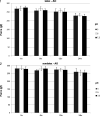The influence of pH levels on mechanical and biological properties of nonlatex and latex elastics
- PMID: 22149622
- PMCID: PMC8845539
- DOI: 10.2319/082811-552.1
The influence of pH levels on mechanical and biological properties of nonlatex and latex elastics
Abstract
Objective: To evaluate the influence of pH levels on interarch elastics with regard to force decay and cytotoxicity.
Materials and methods: One nonlatex (NLAO) group and one latex (LAO) group were tested (n = 10). Elastics were stretched to 25 mm and were held for 1, 6, 12, and 24 hours in artificial saliva solutions with pH levels of 5.0, 6.0, and 7.5. Force magnitudes were measured at 25 mm of activation. The cytotoxicity assay was performed using cell cultures (L929 mouse fibroblast cell line), which were subjected to the cell viability test with neutral red ("dye-uptake"). Force decay and cytotoxicity were assessed using analysis of variance, the Sidak method, and a Tukey's test.
Results: The interactions between group, pH, and time showed no statistically significant differences (P = .29). When pH per time (P = .032) and group per time (P = .0009) were considered, these interactions showed statistically significant differences (P < .05). The pH did not interfere directly in the degradation results of the tested elastics. The cytotoxicity test showed that group LAO presented lower cell viability when compared with group NLAO over the course of the entire experiment. There was a gradual reduction in cell viability from 1 hour to 24 hours. A significant difference (P < .05) was found between the interactions group pH and the control group of cells, except between group NLAO at the time point of 1 hour at different pH values and at the time points of 6 and 12 hours with pH 5 (P > .05).
Conclusions: No significant correlation between pH, force decay, and cytotoxicity was observed.
Figures


Similar articles
-
The effect of pH levels on nonlatex vs latex interarch elastics.Angle Orthod. 2011 Nov;81(6):1070-4. doi: 10.2319/011811-34.1. Epub 2011 May 24. Angle Orthod. 2011. PMID: 21609184 Free PMC article.
-
A comparison of dynamic and static testing of latex and nonlatex orthodontic elastics.Angle Orthod. 2003 Apr;73(2):181-6. doi: 10.1043/0003-3219(2003)73<181:ACODAS>2.0.CO;2. Angle Orthod. 2003. PMID: 12725375
-
Cytotoxicity of orthodontic separating elastics.Aust Orthod J. 2010 May;26(1):16-20. Aust Orthod J. 2010. PMID: 20575194
-
Evaluation of the Loss of Strength, Resistance, and Elasticity in the Different Types of Intraoral Orthodontic Elastics (IOE): A Systematic Review of the Literature of In Vitro Studies.J Pers Med. 2023 Oct 14;13(10):1495. doi: 10.3390/jpm13101495. J Pers Med. 2023. PMID: 37888106 Free PMC article. Review.
-
A review of the clinical applications of elastic tractions in orthodontics.World J Orthod. 2009 Fall;10(3):e12-8. World J Orthod. 2009. PMID: 21793261 Review.
Cited by
-
Influence of different types of mouthwashes on force decay of elastomeric chain recommended in SARS-COV-2 pandemic.J Orthod Sci. 2024 Sep 17;13:34. doi: 10.4103/jos.jos_18_24. eCollection 2024. J Orthod Sci. 2024. PMID: 39450230 Free PMC article.
-
Difference in force decay latex and non-latex elastic band based on duration of elastic use and salivary pH concentration: In vitro study.J Orthod Sci. 2025 Mar 25;14:7. doi: 10.4103/jos.jos_58_24. eCollection 2025. J Orthod Sci. 2025. PMID: 40302887 Free PMC article.
-
Influence of Mouthwash Rinsing on the Mechanical Properties of Polymeric Ligature Ties Used for Dental Applications.Polymers (Basel). 2021 Jul 8;13(14):2236. doi: 10.3390/polym13142236. Polymers (Basel). 2021. PMID: 34300994 Free PMC article.
-
The effect of toothpastes with bleaching agents on the force decay of elastomeric orthodontic chains.Eur J Dent. 2017 Oct-Dec;11(4):427-431. doi: 10.4103/ejd.ejd_83_17. Eur J Dent. 2017. PMID: 29279666 Free PMC article.
-
Influence of different beverages on the force degradation of intermaxillary elastics: an in vitro study.J Appl Oral Sci. 2013 Mar-Apr;21(2):145-9. doi: 10.1590/1678-7757201302256. J Appl Oral Sci. 2013. PMID: 23739862 Free PMC article.
References
-
- Palosuo T, Alenius H, Turjanmaa K. Quantitation of latex allergens. Methods. 2002;27:52–58. - PubMed
-
- Turjanmaa K, Alenius H, Makinen-Kiljunen S, Reunala T, Palosuo T. Natural rubber latex allergy. Allergy. 1996;51:593–602. - PubMed
-
- Santos R. L, Pithon M. M, Martins F. O, Romanos M. T, Ruellas A. C. Cytotoxicity of latex and non-latex orthodontic elastomeric ligatures on L929 mouse fibroblasts. Braz Dent J. 2010;21:205–210. - PubMed
-
- dos Santos R. L, Pithon M. M, Martins F. O, Romanos M. T, de Oliveira Ruellas A. C. Evaluation of the cytotoxicity of latex and non-latex orthodontic separating elastics. Orthod Craniofac Res. 2010;13:28–33. - PubMed
Publication types
MeSH terms
Substances
LinkOut - more resources
Full Text Sources

